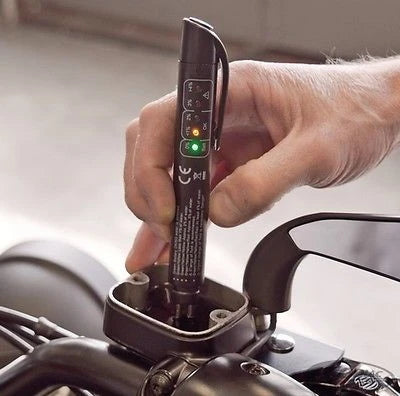
All about the bike brake fluid: which one is better?
Share
Brake fluid is a fundamental component of the braking hydraulic system. It transmits the force exerted on the brake lever to the pistons of the tweezers and also has the function of preventing the formation of water droplets in the circuit to prevent corrosion of the components.

Due to its importance regarding users' safety, the United States Department of Transportation (DOT), demanded that brake fluid manufacturers meet certain safety requirements when manufacturing them. From these requirements arose the DOT indices (DOT 3, DOT 4, DOT 5 and DOT 5.1), all destined to specify the composition of the liquids according to their dry boiling point, their point of wet boiling, its viscosity and the base of the liquid, normally derived from polyglycol but also with silicone bases and even mineral oils:
- Dot 3: Based with Glycol, used in conventional brakes. It has a dry boiling point of 205ºC, wet 140ºC and a 1500cst viscosity. It can be mixed with DOT 4 and DOT 5.1 liquids, although it is not recommended.
- DOT 4: based on Glycol, used in ABS and conventional brakes. It has a dry boiling point of 230ºC, wet 155ºC and a viscosity of 1800cst. It can be mixed with DOT 3 and DOT 5.1 liquids, although it is not recommended.
- DOT 5: Silicone -based, used in high performance brakes without ABS. It has a dry boiling point of 260ºC, wet 185ºC and a viscosity of 900cst. It cannot be mixed with DOT 3, DOT 4 and DOT 5.1 liquids.
- DOT 5.1: Based with Glycol, used in high performance brakes with or without ABS. It has a dry boiling point of 260ºC, wet 180ºC and a viscosity of 900cst. It can be mixed with DOT 3 and DOT 4 liquids, although it is not recommended.
How to choose one or the other?
It is necessary to start from the base that a braking system generates a lot of heat, so the boiling point of brake fluid (the higher, the better) is a very factor to take into account.
Another important fact is that Glycol -based liquids (Dot 4, Dot 5 and DOT 5.1) are hygroscopic (absorb moisture) and, therefore, it has to deteriorate over time and must be changed every 2 or 3 years, while silicone -based liquids (DOT 5) are hydrophobic The rubber joints.
To know the state of the brake fluid, we can use a moisture tester Specific for brakes.
In any case, It is the brake manufacturer in charge of specifying the type of brake fluid that must be used In your product, so the best brake fluid will always be recommended by the motorcycle manufacturer or the braking site.
Frank Burguera
#mecanicaharley


